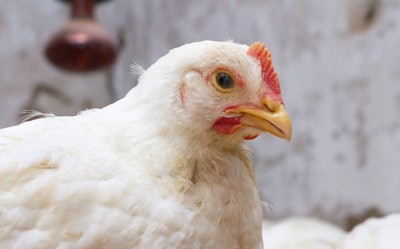
Welfare plays an important role in any poultry production operation, but it can be difficult to accurately assess. Science-based criteria – through the study of enrichment, growth rate, behaviors and more – can create objective ways that producers can use to measure and assess poultry welfare.
Most farm animals are prey animals. They evolved to instinctively hide pain. Several researchers in academia now target the development of practical assessments that both benefit the well-being of the birds and can realistically be applied in commercial operations.
During Flocking Together to Address Poultry Welfare Challenges, an online and live symposium hosted by the University of Arkansas, on October 12, 2022, industry experts shared how research addresses gaps in poultry welfare knowledge.
Nutritional immunology
Nutritional immunology focuses on the intersection of nutrition and the immune system. In other words, how the diet impacts overall poultry health. In addition, by assessing the metabolic changes in poultry, its possible to more accurately measure their response to disease and stress challenges, Elizabeth Bobeck, associate professor at Iowa State University, said.
“My group does a lot with nutrition and immunology and over the past six to seven years, we’ve also added some welfare and environment research to our portfolio. I think one of the most interesting things about research is that sometimes when you have an outside view on a problem, you can approach it in a more creative way,” she said.
“Something that my group has been doing is trying to develop new ways and approaches to support performance outcomes.”
There are several new technological tools to help researchers monitor immunometabolism changes and identify biomarkers that give insight into the inflammatory status of the bird, including polymerase chain reaction (PCR), enzyme-linked immunosorbent assays (ELISAs) and improvements to flow cytometry. One of these techniques, seahorse metabolic assay, quantifies the rate of ATP production from anaerobic and aerobic respiration simultaneously.
“Our hope is that if we’re able to measure those metabolic changes, we can apply a challenge to the bird, we can apply a challenge to the environment and we can even apply a challenge to the cell itself and we’ll be able to measure their ability to respond to these challenges,” Bobeck said.
Research revealed that the seahorse metabolic assay accurately measures differences in poultry inflammatory status to stressors, including pathogens and other potential causes of disease.
This type of research has several implications for future poultry welfare research. The technique shows promise for studying the effects of housing types on immune response, connecting potential stressors to welfare, the systemic effects of immune-related feed additives and the development of more accurate precision feeding recommendations based on immune stimulations.
Cognitive bias testing
Initially used in human psychology, poultry welfare researchers have adapted cognitive bias testing as a good way to noninvasively measure stress in broilers using their affective states.
“Items in the environment for broilers provide them with an opportunity to choose what they do and choice is very important for animal welfare,” Leonie Jacobs, assistant professor at Virginia Tech, said. “Providing them with variety and complexity in their environment gives them to opportunity to explore or eat or rest and that improves their welfare outcomes and quality of life.”
Environmental enrichment – such as ramps, straw bales, platforms and more – improves broilers health and welfare outcomes in several ways. Behavior is typically the first benefit people think of when it comes to poultry welfare, but enrichment also impacts activity and the bird’s affective state.
“Affective states are long term moods or emotional states that result from an accumulation of experiences. It’s not how you feel in response to one specific thing, but more your overall state,” Jacobs noted.
There are two forms of cognitive bias testing, judgement bias, which evaluates a bird’s response to ambiguous stimuli, and attention bias, that monitors the tendency to prioritize the processing of certain types of stimuli over others.
For example, when measuring judgement bias, researchers might measure how often a broiler chooses between a bowl containing a treat (positive stimuli) and an empty bowl (ambiguous stimuli).
It seems straightforward, until you introduce a novel object. Because poultry are prey animals, they are less likely to explore new objects and more likely to display fear behavior when they are stressed. Therefore, this test serves as an easy way to measure whether animals are in a positive affective state.
Conversely, attention bias tests rely on the tendency to pay attention to negative stimuli over other factors present in the environment. An example of an attention bias test is comparing the response between an alarm bell and a treat.
“The more vigilant these birds are, the more anxious they are because they focus on the negative rather than the positive. We present the two stimuli simultaneously and then measure how long it takes for the birds to start eating,” Jacobs said.
This type of poultry welfare evaluation could take poultry welfare research in numerous research directions, including determining the ideal amount of enrichment to provide welfare benefits to broilers, the benefits of enrichments for other broiler strains and changes to welfare status as conditions change in the barn.
VIDEO: SMART Broiler welfare initiative enters new phase WATTAgNet.com/articles/45976















